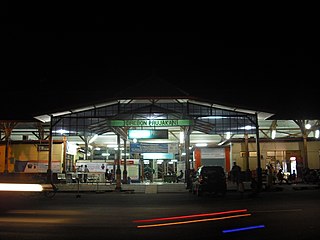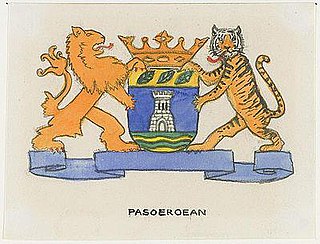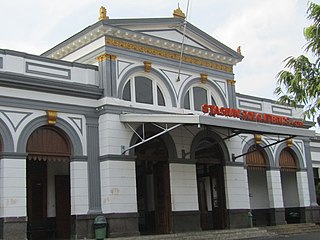
The majority of Indonesia's railways are on Java, used for both passenger and freight transport. There are three noncontinuous railway networks in Sumatra while two new networks are being developed in Kalimantan and Sulawesi. Indonesia has finalized its plan for a national railway network recently. According to the plan, 3,200 km of train tracks that will criss-cross the islands of Sumatra, Java, Kalimantan, and Sulawesi, it has been touted as the most extensive railway project in Indonesia since its independence from the Dutch in 1945. Indonesia targets to extend the national railway network to 10,524 kilometres by 2030. As of September 2022, the network spans 7,032km.

PT Kereta Api Indonesia (Persero) (English: Indonesian Railways Company, abbreviated as PT KAI or simply KAI) is the sole operator of public railways in Indonesia. It is completely state-owned and pays track access charges to the government. The headquarters of KAI are located in Bandung, West Java.

Padalarang Station (PDL) is a railway station complex in Padalarang, West Bandung Regency, West Java, Indonesia. The complex is planned to serve long-distance train services from Kereta Api Indonesia, commuter trains from KAI Commuter, and Jakarta-Bandung high-speed trains from Kereta Cepat Indonesia-China (KCIC). The complex is in the form of two different station buildings, each operated by KAI and KCIC, and will be connected via a pedestrian bridge.

Surabaya Pasar Turi Station or Surabaya Pasarturi Station (SBI) is the second largest railway station in Surabaya, East Java. Located near the biggest market Pasar Turi, Semarang 1 street, Gundih, Bubutan, Surabaya. Pasar Turi Station has passenger trains that travel to the west of Surabaya such as to Jakarta and Semarang. This station is main departure point of all train from city of Surabaya which passes through Pantura, but train south and east line from city of Surabaya departed from Surabaya Gubeng. Since 2014, the station has upgraded railway signal and railroad switch devices from mechanical to electrical type produced by PT. LEN Indonesia.

Cirebon Prujakan Station (CNP) is a railway station in Cirebon, West Java, Indonesia. The station is located at a height of 4 metres above sea level is located at Nyimas Gandasari Street, Pekalangan, Pekalipan, Cirebon. Cirebon Prujakan Station is the largest station on DAOP 3 Cirebon after Cirebon Station and Jatibarang Station.

Wonokromo Station (WO) is a large class type C railway station in Jagir, Wonokromo, Surabaya, East Java. The station is located about 5 kilometers (3 mi) south of Surabaya Gubeng Station. This station is the railway junction from Surabaya Gubeng station, Sidoarjo and to Madiun.

Jatibarang Station is a railway station at Mayor Sangun Street (Market), Jatibarang, Jatibarang, Indramayu Regency, West Java. It is on the main northern Java route line from Jakarta to Surabaya.

Bogor Station (BOO), formerly Buitenzorg Station is a railway station located in the city of Bogor, West Java. This station serves as the terminus for the Red Line service of KRL Commuterline. The station has five island platforms and two side platforms. The station is located +246 meter above sea level.
Most railway lines in Indonesia were constructed during the Dutch colonial rule. After independence in 1945, many lines were abandoned. The current national rail operator, PT Kereta Api Indonesia (Persero), was founded on 28 September 1945.

Semarang Poncol Station (SMC) is a historic railway station in Purwosari, North Semarang, Semarang, Indonesia. The station which is located at an altitude of +3 meters is included in the Semarang Operational Area IV and is the second main station in Semarang after Semarang Tawang Station. It was built in 1914 and is considered an early example of Art Deco architecture.

Nambo Station (NMO) is a railway station located in Bantar Jati, Klapanunggal, Bogor Regency. Together with three other stations located on this line, it was only inaugurated in 1997, which makes it one of the newest station in the network. At the beginning, this line was planned to be incorporated into a larger circular line network, ranging from Cikarang, via Jonggol to Parung Panjang. This plan had to be postponed due to the 1997 economic crisis.

The Madoera Stoomtram Maatschappij on Madura Island today's Indonesian province of Jawa Timur was one of the railway companies in the Dutch East Indies. The company had its headquarters in The Hague and was licensed in 1896. In 1901 it put the first steam trams in operation to connect the western with the eastern end of the island.

The Pasoeroean Stoomtram Maatschappij, N.V. was a private tramway in Pasuruan on the Dutch East Indies. It served passenger transport as well as goods transport of agricultural products such as sugarcane, tea and tobacco.

The Samarang–Joana Stoomtram Maatschappij, N.V. was from 1879 to 1959 a private tram company on the Dutch East Indies, providing passenger and freight trains on a 417 kilometres (259 mi) long network with a gauge of 3 feet 6 inches (1,067 mm).

Kertosono Station is a type-B major railway station in Banaran, Kertosono, Nganjuk Regency, East Java, Indonesia, operated by Kereta Api Indonesia, located at 400 m south of Kertosono Market. The station is the most eastern and the largest railway station in Nganjuk Regency.

Jombang Station (JG) is a large class type C railway station located in Jombatan, Jombang, Jombang Regency, the station is included in the Operation Area VII Madiun at an altitude of +43 m. The location of this station is right across the Alun-alun Jombang. All trains passing the Kertosono-Surabaya Gubeng must stop at this station.

Cikampek Station (CKP) is a large class type B railway station located in Cikampek Kota, Cikampek, Karawang Regency. The station, which is located at an altitude of +46 meters, is the station that is located in the easternmost part of the Jakarta Operational Area I and Karawang Regency, and is the largest railway station in Karawang Regency.

Solo Jebres Station, also known as Jebres Station, is a type-C large class railway station in Surakarta, Central Java, Indonesia. The station, which is located 97 metres (318 ft) above sea level, is operated by Operational Area VI Yogyakarta of Kereta Api Indonesia (KAI). It is one of the major railway stations in the city.

Bangil Station (BG) is a class I (one) railway station located in Pogar, Bangil, Pasuruan Regency; entered within eastern border of Operational Area VII Surabaya of Kereta Api Indonesia (KAI) at the height of ± 9 meters above sea level. To the east of this station, there are branches towards Pasuruan-Probolinggo-Jember-Banyuwangi and to Malang.





















